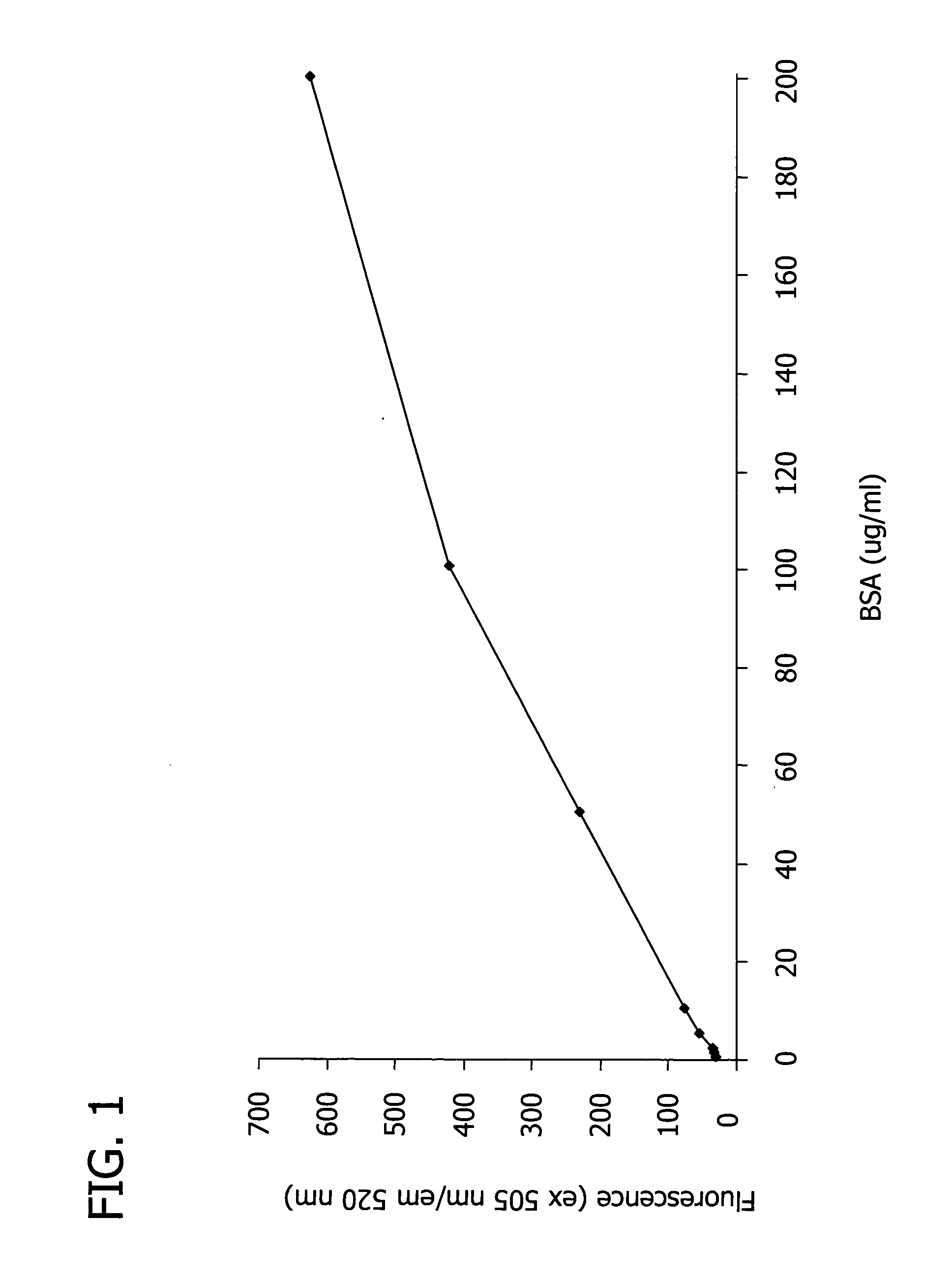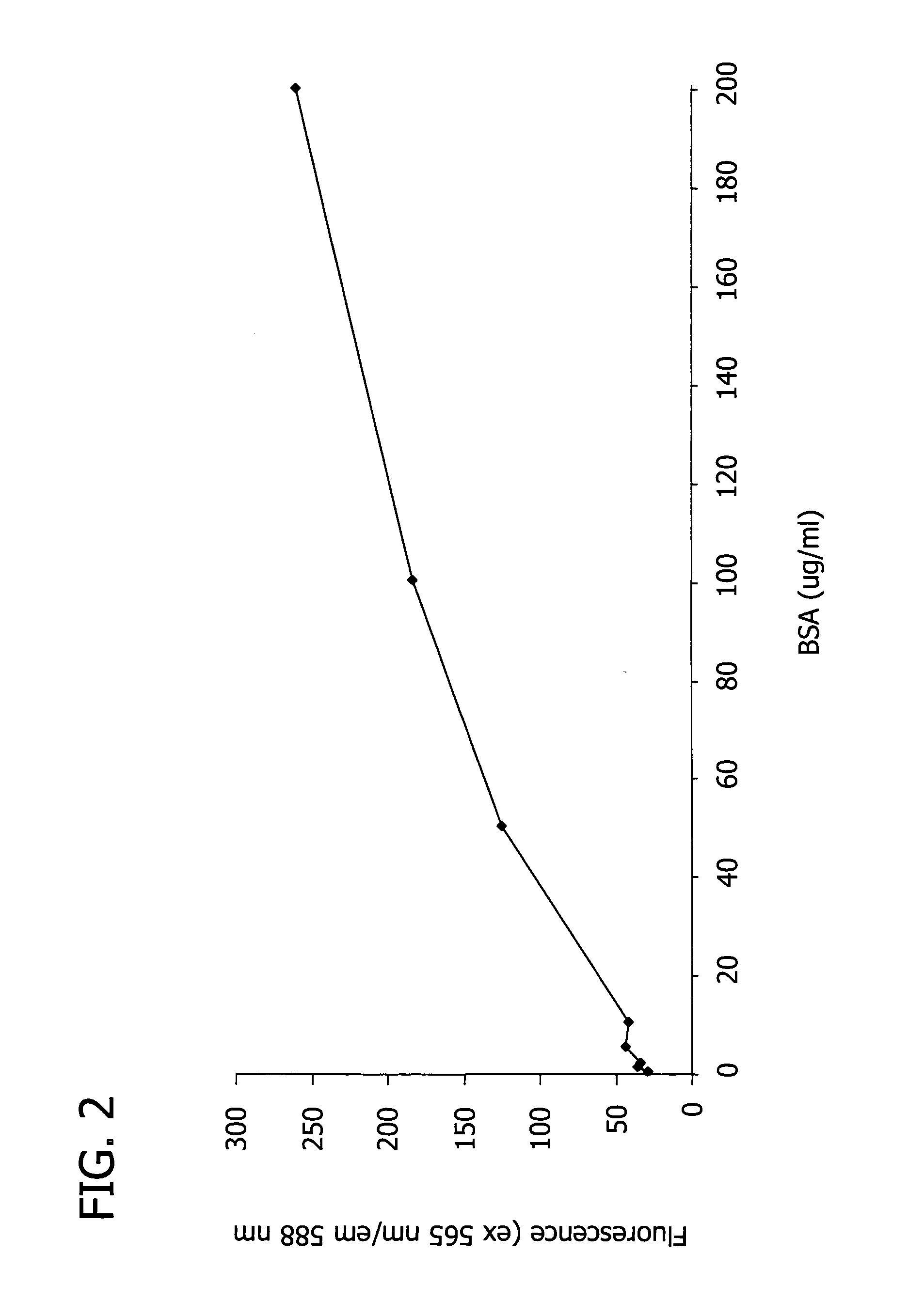Detection of polyamino acids using trimethincyanine dyes
a technology of trimethincyanine and polyamino acids, which is applied in the direction of fluid pressure measurement, liquid/fluent solid measurement, peptides, etc., can solve the problems of high signal loss, inability to visualize by the naked eye, and electrophoretically separated polyamino acids, etc., to achieve easy stripping of easy to detect polyamino acids in a relatively short period of tim
- Summary
- Abstract
- Description
- Claims
- Application Information
AI Technical Summary
Benefits of technology
Problems solved by technology
Method used
Image
Examples
example 1
Determining the Spectroscopic Properties of Suitable Trimethincyanine Dyes
[0127] In this Example, the spectroscopic properties of the trimethincyanine dyes listed in Table 1 were measured, and the theoretical efficiency of the dyes was estimated.
[0128] First, two solutions of each trimethincyanine dye listed in Table 1 were created by adding the trimethincyanine dye to separate solutions of (i) 0.05 M Tris-HCl buffer and (ii) 0.05 M Tris-HCl buffer with 0.05% SDS and 0.2 mg / ml bovine serum albumin (BSA). The concentration of the trimethincyanine dye in each solution was about 1×10−5 M. The fluorescence of each solution was excited at the maximum wavelength of the fluorescence excitation spectrum and recorded. The efficiency of the trimethincyanine dyes was measured by comparing the spectral-luminescent value of the solution containing dye, buffer, SDS, and BSA (i.e., solution (ii)) with the solution containing only dye and buffer (i.e., solution (i)).
[0129] Table 2 illustrates th...
example 2
Detection of Polyamino Acids on an SDS-PAGE Gel
[0130] In this Example, a sample was electrophoretically separated on an SDS-PAGE gel, the gel was combined with a trimethincyanine dye listed in Tables 1 and 2, and the polyamino acids present in the sample were optically detected with a blue light transilluminator.
[0131] First, a sample buffer (0.0625 M Trizma-HCl (pH 6.75), containing 2% SDS, 5% 2-mercaptoethanol, 10% glycerol and 0.001% bromophenol blue) was prepared according to the method of Lämmli (Nature 227, 680-685 (1970)). To 1 ml of the sample buffer was added 1-10 mg of a mixture of three proteins, bovine serum albumin (BSA) (67 kD), ovalbumin (29 kD), and carboanhydrase (29 kD) (available from Sigma-Aldrich Co., St. Louis, Mo.) to form the sample. The sample was incubated in boiling water for 60 seconds. A portion of the sample was then diluted 20 to 2000 times in sample buffer and loaded onto a 10-20% precast Novex-Gel (EC61352, Invitrogen, Carlsbad, Calif.). A protein ...
example 3
Detection of Polyamino Acids on an SDS-PAGE Gel with an Additional Fixation Step
[0134] In this Example, a sample was analyzed according to the procedure described in Example 2; however, in this Example, following electrophoresis, the gel was incubated in 5% trichloroacetic acid for 30 minutes, and then soaked in a 0.05% SDS solution for 30 minutes.
[0135] Following this additional fixation step, the gel was stained with a staining solution (˜50 ml). The staining solution was prepared by diluting 5000 times in sodium acetate buffer (pH 4.5) a stock solution (5 mg in 1 ml DMSO) of Dye I.D. No. U from Tables 1 and 2.
[0136] The gel was illuminated with an ultraviolet screen and photographed according to the procedure described in Example 2. LOD reached 5-10 ng / band for each of the three proteins in the sample.
PUM
| Property | Measurement | Unit |
|---|---|---|
| Fraction | aaaaa | aaaaa |
| Fraction | aaaaa | aaaaa |
| Fraction | aaaaa | aaaaa |
Abstract
Description
Claims
Application Information
 Login to View More
Login to View More - R&D
- Intellectual Property
- Life Sciences
- Materials
- Tech Scout
- Unparalleled Data Quality
- Higher Quality Content
- 60% Fewer Hallucinations
Browse by: Latest US Patents, China's latest patents, Technical Efficacy Thesaurus, Application Domain, Technology Topic, Popular Technical Reports.
© 2025 PatSnap. All rights reserved.Legal|Privacy policy|Modern Slavery Act Transparency Statement|Sitemap|About US| Contact US: help@patsnap.com



